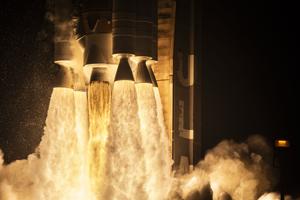Science
SpaceX Launches Falcon 9 to Deploy 29 Starlink Satellites

SpaceX is set to launch a Falcon 9 rocket from Cape Canaveral Space Force Station in the early hours of Saturday, continuing its ambitious expansion of the Starlink internet service. The launch is scheduled for 1:59 a.m. EST (0659 UTC) and will take place at Space Launch Complex 40. This mission marks the ninth of up to 11 planned Starlink launches for the month and the 109th delivery run for the Falcon 9 rocket in 2023.
The 45th Weather Squadron has predicted near-perfect conditions for the launch, estimating a less than five-percent chance of weather-related delays. Live coverage of the event will begin an hour prior to liftoff, providing enthusiasts and stakeholders with real-time insights into the mission.
Mission Details and Objectives
Once the Falcon 9 lifts off from Cape Canaveral, it will follow a south-easterly trajectory to deploy a payload of 29 Starlink V2 satellites into a designated orbit inclined at 43 degrees to the Equator. The mission will utilize booster B1090, which is on its ninth flight, demonstrating the reusability that has become a hallmark of SpaceX’s operations.
After separating from the Falcon 9’s second stage at an altitude of approximately 40 miles (65 km), the first stage will ascend further, crossing the Karman line—the internationally recognized boundary of space—before returning to Earth. It will land on the drone ship named A Shortfall of Gravitas, which will be stationed in the Atlantic Ocean.
The second stage of the Falcon 9 will ignite for around six minutes to place the Starlink satellites into a parking orbit. After a coasting phase of about 45 minutes, it will execute a brief burn of its Merlin Vacuum engine to circularize the orbit. The separation of the satellites is expected to occur one hour and five minutes into the flight, positioning them in a 170×162 mile (274×261 km) orbit.
Looking Ahead
This launch is part of SpaceX’s ongoing efforts to enhance global internet coverage through its growing constellation of satellites. Following this mission, another 28 satellites are scheduled for launch from the West Coast on Sunday morning, further expanding the Starlink network.
As SpaceX continues to push the boundaries of satellite technology and space travel, each successful launch contributes to the company’s goal of providing high-speed internet access to underserved regions around the world. The Falcon 9’s reliability and efficiency have made it a key player in the commercial space sector, underscoring the importance of innovation in the aerospace industry.
-

 Technology5 months ago
Technology5 months agoDiscover the Top 10 Calorie Counting Apps of 2025
-

 Technology2 weeks ago
Technology2 weeks agoOpenAI to Implement Age Verification for ChatGPT by December 2025
-

 Health3 months ago
Health3 months agoBella Hadid Shares Health Update After Treatment for Lyme Disease
-

 Health3 months ago
Health3 months agoAnalysts Project Stronger Growth for Apple’s iPhone 17 Lineup
-

 Health3 months ago
Health3 months agoErin Bates Shares Recovery Update Following Sepsis Complications
-

 Technology5 months ago
Technology5 months agoDiscover How to Reverse Image Search Using ChatGPT Effortlessly
-

 Technology3 months ago
Technology3 months agoElectric Moto Influencer Surronster Arrested in Tijuana
-

 Technology2 months ago
Technology2 months agoDiscover 2025’s Top GPUs for Exceptional 4K Gaming Performance
-

 Technology5 months ago
Technology5 months agoMeta Initiates $60B AI Data Center Expansion, Starting in Ohio
-

 Technology5 months ago
Technology5 months agoRecovering a Suspended TikTok Account: A Step-by-Step Guide
-

 Health5 months ago
Health5 months agoTested: Rab Firewall Mountain Jacket Survives Harsh Conditions
-

 Lifestyle5 months ago
Lifestyle5 months agoBelton Family Reunites After Daughter Survives Hill Country Floods



















